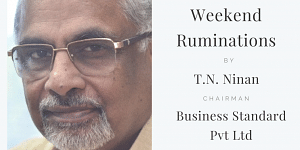Nothing would be lost in making details of Rafale deal public, especially since the broad numbers are already available.
The Congress effort to make the 36-jet Rafale deal the Bharatiya Janata Party’s Bofors, and to snare Narendra Modi in its exhaust fumes just as Bofors flattened Rajiv Gandhi, may or may not succeed. Not because pay-offs did or did not exist. Almost all defence deals of this kind involve pay-offs at different levels–as anyone who is not a babe in the wood knows. But it is hard to get conclusive facts, and there is no evidence available of bribes in the case of Rafale.
The difference between the two cases is that the Bofors scandal erupted following a Swedish radio broadcast and a panic-stricken response by the Rajiv government. The issue became a scandal in Sweden, not just India, and set off prosecutorial activity there. Without that (combined with good media sleuthing), the precise amount of the pay-offs and the identities of beneficiaries would not have become public. Nothing of the kind is likely to happen in France.
 The Rafale brouhaha therefore is only in India, and is focused on establishing that the deal which Mr Modi and his government signed involves a higher price per aircraft than the one that the previous Congress-led government was negotiating. But a one-to-one comparison for such complex weapon packages is next to impossible to work out and be beyond dispute. The relevant years are different and bring in the inflation factor, the numbers of aircraft are different, the nature of the contract (buy vs buy-plus-make) is different, the add-ons are different, the weapons package is different, and the post-purchase maintenance terms and guarantees are different. Assuming for the sake of argument that pay-offs exist, they can easily be masked.
The Rafale brouhaha therefore is only in India, and is focused on establishing that the deal which Mr Modi and his government signed involves a higher price per aircraft than the one that the previous Congress-led government was negotiating. But a one-to-one comparison for such complex weapon packages is next to impossible to work out and be beyond dispute. The relevant years are different and bring in the inflation factor, the numbers of aircraft are different, the nature of the contract (buy vs buy-plus-make) is different, the add-ons are different, the weapons package is different, and the post-purchase maintenance terms and guarantees are different. Assuming for the sake of argument that pay-offs exist, they can easily be masked.
So it is hard to understand why the government treats the price details as secret. Nothing would be lost in making them public, especially since the broad numbers are already available. The point is that even if the government were to adopt a transparent approach on the cost details, much of the information on the deal would have to be kept secret and that would come in the way of a proper comparative assessment.
Meanwhile, the scandal which does not need any unearthing because it stares the country in the face, is the way defence purchases are being done, or not done. The need for 126 fighter aircraft was established in 2001, but a request for proposals from fighter aircraft manufacturers went out only in 2007. The Rafale was chosen in 2012, but reports said the actual cost was proving to be twice what had initially been put out. So price haggling went on for two years, until there was a change of government. A year after that, and eight years after the request for proposals, Mr Modi did a bilateral deal for two of the original seven squadrons. Suddenly, the air force’s need for an additional five squadrons became unimportant, without explanation.
Naturally, the air force continues to be short of planes. So, more than a decade after the last selection round got under way, the same process is about to start again for the same kind of aircraft, naturally with the same likely bidders. If the country is lucky, an order may be placed in five years and the planes start getting delivered a couple of years after that. That would take the time table to 2025—and nearly a quarter-century of contracting effort.
This is not an isolated example. In 1999 the government decided on ordering conventional submarines; half a dozen were to be commissioned by 2012, and another half-dozen after that. So far, in 2018, the navy has commissioned one submarine, instead of a possible 12. There are similar stories concerning the army, like taking 30 years to sign the first howitzer deal after Bofors. None of this is a secret. Indeed, all of it and more has been aired repeatedly in the media by very competent writers, but the defence acquisition system seems paralysed and incapable of change. Why doesn’t Parliament hold the government to account on this issue?
By Special Arrangement with Business Standard.
Also Read: Modi should not allow Rafale jet deal to become another Bofors
Also Read: Controversy, not a scam: Can’t let Rafale heat freeze military modernisation




good article which brings out the fact there is no accountability for the Parliament. ..the ministers simply decide their own pay and perks, take privileges and pension with ZERO accountability. …tomorrow if there is a war, and it’s not far away, and God forbid if things don’t go as expected, the ministers will simply put the blame on armed forces…there won’t be any questions asked from them. …the COAS, CAS, CNS may lose their jobs, more so their honour but not a scratch will come over any minister or for that matter any bureaucrat, be it Def Secy or Secy of Production or DRDO or Scientific Advisor to RM , they all will simply wash their hands off…thus no doubts about this brushing away responsibility and no accountability is the biggest bane of this system. …good at least PM Modi and current govt took a decision and moved only as step. ..but at lest a step has been taken …the same needs to be followed up or else we will be left good only for conducting surgical strikes and not defend nation especially against China, forget about the two front scenario
Rafale deal has got some vital flaws, if I am correct. One 36 fighter get is purchased through AMBANI group. It is clear the price quoted is much higher than the sale proceeds by other countries. There cannot be a fake silencing clause in an agreement , which, they say speaks of non disclosure. Transfer of technology is also a vital issue. Bluntly , it shall be one of the substantial provision
This not right that Imran Khan has took help from religious extremists. For example Tehreek e Labaik Pakistan has took part in elections through out the country, they have not supported ImranKhan.
Second: In district Jhang, Imran Khan’s candidates defeated Mohammed Ahmed Ludhianvi and Asif Mawaiya, who are alleged extremist.
Please make correction
https://www.financialexpress.com/india-news/rafale-deal-taxpayers-will-pay-rs-1-lakh-crore-says-rahul-gandhi/1261630/
An excellent article. The moot point to be considered is why the UPA deal couldn’t be finalised and signed till March 2014, when Dassault Aviation was already declared L-1 bidder in 2012. Why did it take 2 long years to finalise terms and conditions of the deal. It seems from the news report that A.K.Antony, the then Defence Minister himself was not happy with the deal and therefore delayed finalisation thereof. Our defence purchases are so trapped in the maze of confusing rules, regulations and procedures that opposition parties can have ample opportunities in picking up holes in the purchase decisions. This creates fear psychosis amongst the decision makers. It becomes safe not to make decisions and prolong the acquisition process rather than to face music in the Parliament. The Manmohan Singh regime adopted the same delaying strategy, though it had an adverse impact on our defence preparedness. Modi could have adopted the same strategy, blamed the predecessor regime and simply scrapped the earlier deal stating that it was non-implementable and thereafter do nothing . That the UPA deal was non-implementable was could be seen due to few obvious reasons: (1) The cost of manufacturing 108 planes at HAL, India was a projected cost and not actual cost. The consequent pricing was, therefore, just an uncertain wishful number, most unsuitable for any future comparison or reference.(2) Dassault Aviation was not willing to undertake ownership of the quality and delivery of the fighter planes to be manufactured in India. (3)Dassault had arrived the number of man-days required to complete the production of 108 as per European standards. HAL didn’t agree and estimated 2.7 times that number indicating manifold increase in the production cost. Thus, it is evident that the ‘ Transfer of Technology’ theory, though appears very attractive on paper, it is simply not practical to implement it, more particularly when the contracting party is a private entity. Obviously, Dassault is not Soviet Union and Rafale is no MIG. So, the UPA deal was a non-starter since inception. Whatever may be the lacunaes in the Modi deal, at least one thing is certain: he dared to decide and implement his decision notwithstanding the prospects of virulent criticism that he had to face. Now, at least the nation would be getting 36 fighter planes with state of the art technology, which may possibly include capability to carry nuclear weapons, though by circumventing the Nuclear Proliferation Treaty.